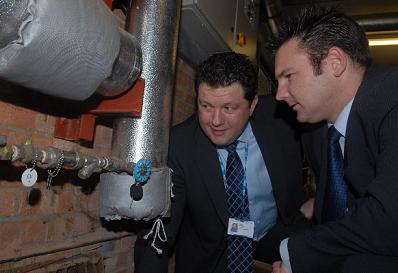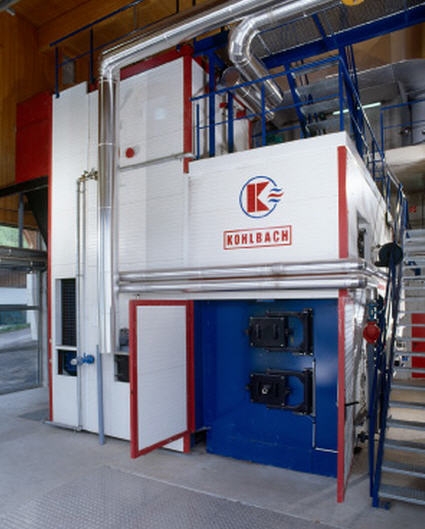As the largest employer in the UK, the NHS has a major role to play in helping the country meet the targets of the Climate Change Act. According to a study conducted by the Sustainable Development Commission and the Stockholm Environment Institute, the UK health service has a carbon footprint of 18m tonnes of CO2 a year - and 22% of its carbon output can be attributed to the energy it uses.
The NHS carbon reduction strategy for England, Saving Carbon, Improving Health, recommends: “Investing in the energy efficiency and resilience of the estate is particularly important in view of the current supply climate, escalating fuel costs and the potential impact of ‘peak oil’. Switching to low carbon forms of energy, such as renewables helps to guarantee supply and reduce the carbon footprint of the estate.”
It is one strand in a multi-layered strategy that aims to reduce the level of carbon emissions by 10% by 2015 (from 2007 levels) and to reach a 26% reduction five years later.
Kingston Hospital in Surrey installed a Dalkia combined heat and power (CHP) system in 2005 after its boilers had reached the end of their operational life. CHP engines generate electricity and the heat emitted from the engine can be captured and used for hot water and heating, making the system more than twice as efficient as conventional power generation.
To meet the hospital’s heating, cooling and electricity needs, Dalkia designed and built a new energy centre that included a 1.4MWe gas-fired CHP engine and waste heat boiler, two additional boilers, a 330kW absorption chiller, heat exchangers and a high and low-voltage switchboard. The new plant was installed into the footprint of the existing building. The system was funded through a £2.9m public-private partnership (PPP) agreement which included 15 years support and maintenance. As a result, carbon emissions for the 632-bed hospital have been cut by around 4,000 tonnes a year, with annual cost savings of around £245,000.
At Garston NHS Treatment Centre in Liverpool, a ground source heat pump (GSHP) system will provide around 50% of the heating and cooling requirements by drawing both heat and cooling from the ground. Regeneco, which designed the system, says the annual energy draw from the ground will be around 150MWh. The project is part of a 20-year framework partnership agreement for construction services with Liverpool and Sefton Partnership, a public-private partnership that includes Liverpool and Sefton PCT, Community Health Partnerships and private sector partner, Galliford Try. The treatment centre will accommodate GP surgeries, a pharmacy and dentistry, audiology and podiatry services.
To help make CHP systems work even more efficiently, GEM has developed the FLU-ACE condensing heat recovery system and the GEM Orifice Venturi steam trap; a non-mechanical steam trap to increase the efficiency of both heat generation and steam leakages. Salisbury District Hospital replaced its traditional thermodynamic steam traps with 70 GEM steam traps last year to try to reduce its steam consumption. As a result, steam consumption has reduced by around 10%.

According to a GEM spokesman: “Savings in energy alone will enable the hospital to receive a payback on the installation in just 18 months.”
Another solution a number of trusts have chosen is a biomass boiler. Fraser Weir from Scotland-based Buccleuch BioEnergy says biomass is particularly suited to NHS applications because it is designed to meet the round-the-clock energy needs of the health service. “Biomass is a very attractive solution for high energy use buildings such as hospitals,” he added. “It provides the intensity of energy required, while maintaining a good degree of control over the level of energy generation, which other renewable energy solutions often fail to offer, such as solar or wind,” Weir adds.
Biomass systems use wood chip sourced from sustainably-managed forests local to the biomass installation. According to Weir, installation of the systems can reduce carbon emissions by around 75% when compared with gas, and by around 90% in comparison with traditional oil systems. In addition, the ash created from burning the wood chips has a secondary use as fertiliser.

Buccleuch is installing and commissioning a Kohlbach K8-1500kW biomass steam boiler, a new natural gas turbine CHP unit and two duel fuel boilers at Aberdeen Royal Infirmary’s new energy centre.
Weir says: “Our existing installations have proven that significant energy cost savings are being achieved. Again this is down to the elimination of exposure to volatile international markets for fossil fuels. Furthermore financial incentives such as the Renewable Heat Incentive (RHI) give a boost to the savings that biomass can achieve.
“The RHI will be brought in later this year and will assist in reducing the investment payback period for the installation of biomass systems.”
As the pressure on trusts to become more efficient increases, systems like these will not only benefit the environment, but in the longer term will also reap economic benefits in energy savings.
